MITSUBISHI ASX 2018 Owner's Manual (in English)
Manufacturer: MITSUBISHI, Model Year: 2018, Model line: ASX, Model: MITSUBISHI ASX 2018Pages: 514, PDF Size: 34.89 MB
Page 341 of 514
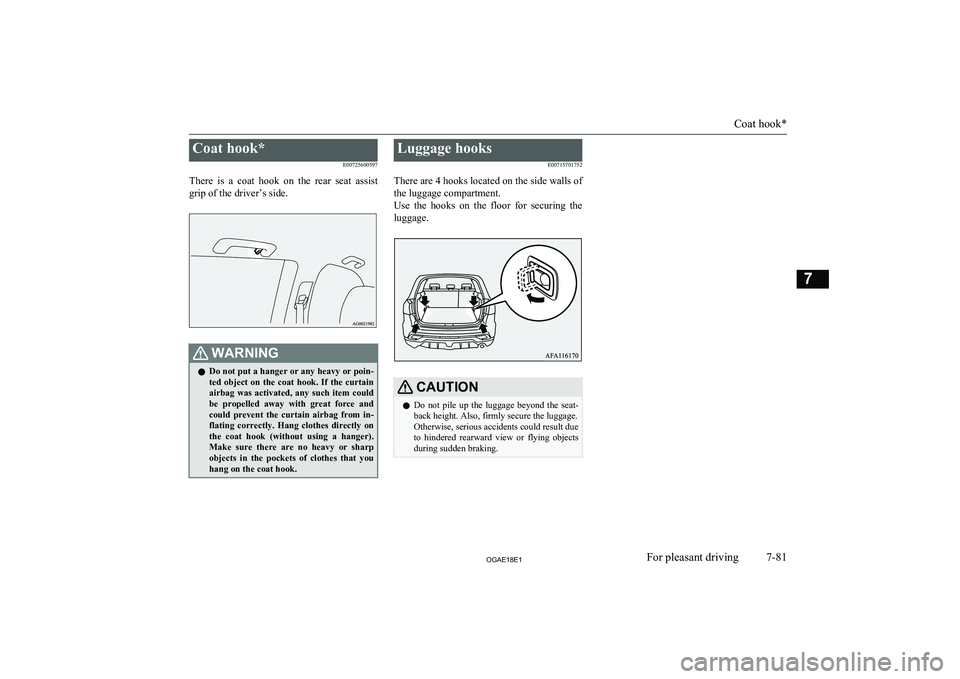
Coat hook*E00725600597
There is a coat hook on the rear seat assist
grip of the driver’s side.WARNINGl Do not put a hanger or any heavy or poin-
ted object on the coat hook. If the curtain
airbag was activated, any such item could
be propelled away with great force and could prevent the curtain airbag from in-
flating correctly. Hang clothes directly on the coat hook (without using a hanger).
Make sure there are no heavy or sharp objects in the pockets of clothes that you
hang on the coat hook.Luggage hooks
E00715701752
There are 4 hooks located on the side walls of
the luggage compartment.
Use the hooks on the floor for securing the luggage.CAUTIONl Do not pile up the luggage beyond the seat-
back height. Also, firmly secure the luggage.
Otherwise, serious accidents could result due
to hindered rearward view or flying objects
during sudden braking.
Coat hook*
7-81OGAE18E1For pleasant driving7
Page 342 of 514
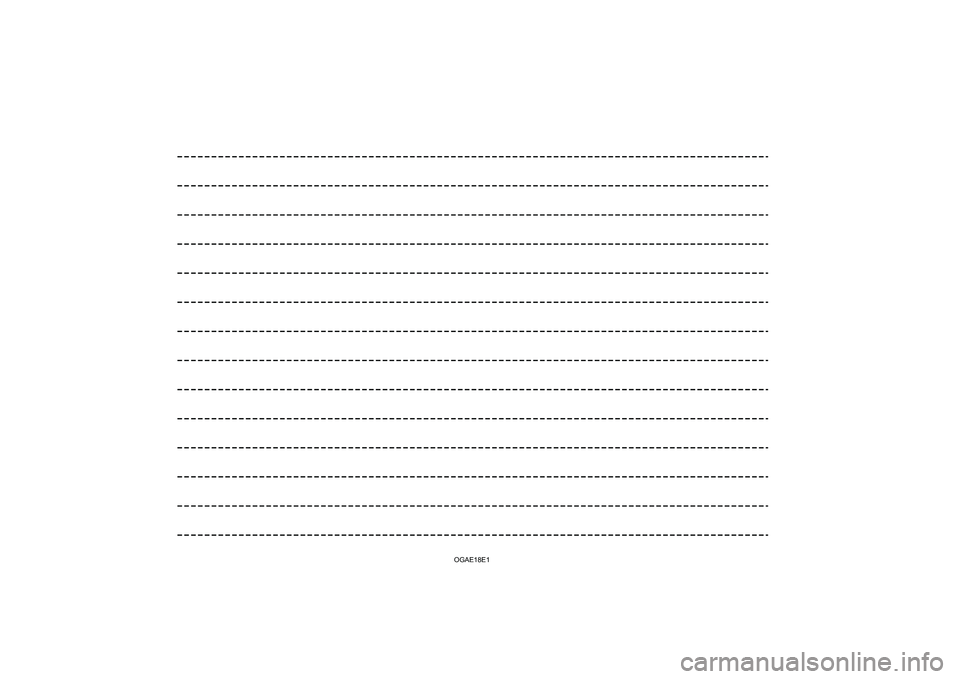
OGAE18E1
Page 343 of 514
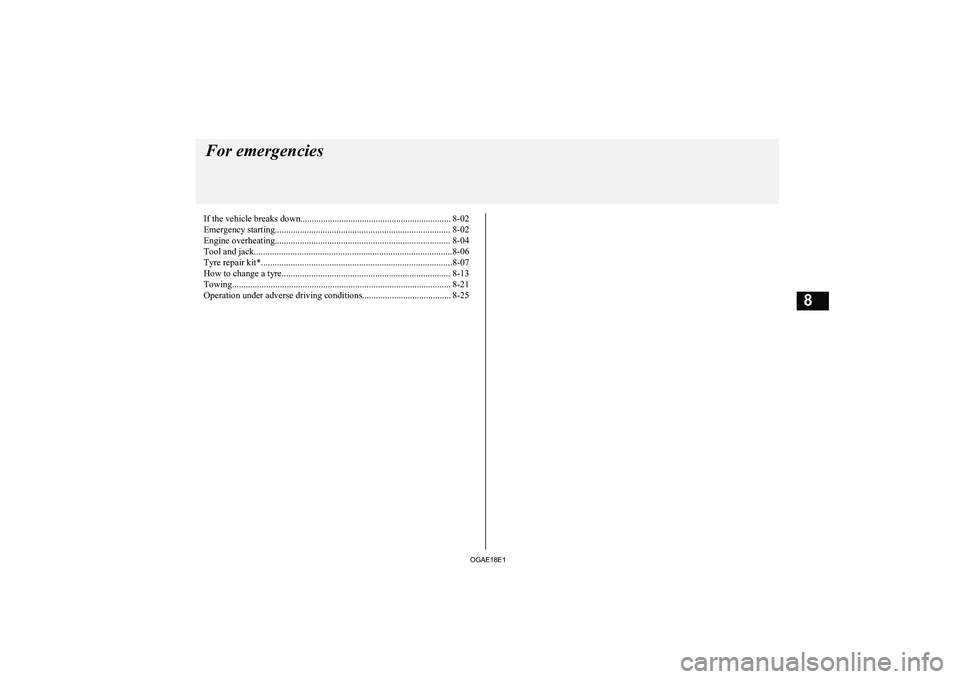
If the vehicle breaks down.................................................................. 8-02Emergency starting............................................................................. 8-02
Engine overheating............................................................................. 8-04
Tool and jack.......................................................................................8-06
Tyre repair kit*....................................................................................8-07
How to change a tyre.......................................................................... 8-13
Towing................................................................................................ 8-21
Operation under adverse driving conditions....................................... 8-25For emergencies
OGAE18E18
Page 344 of 514
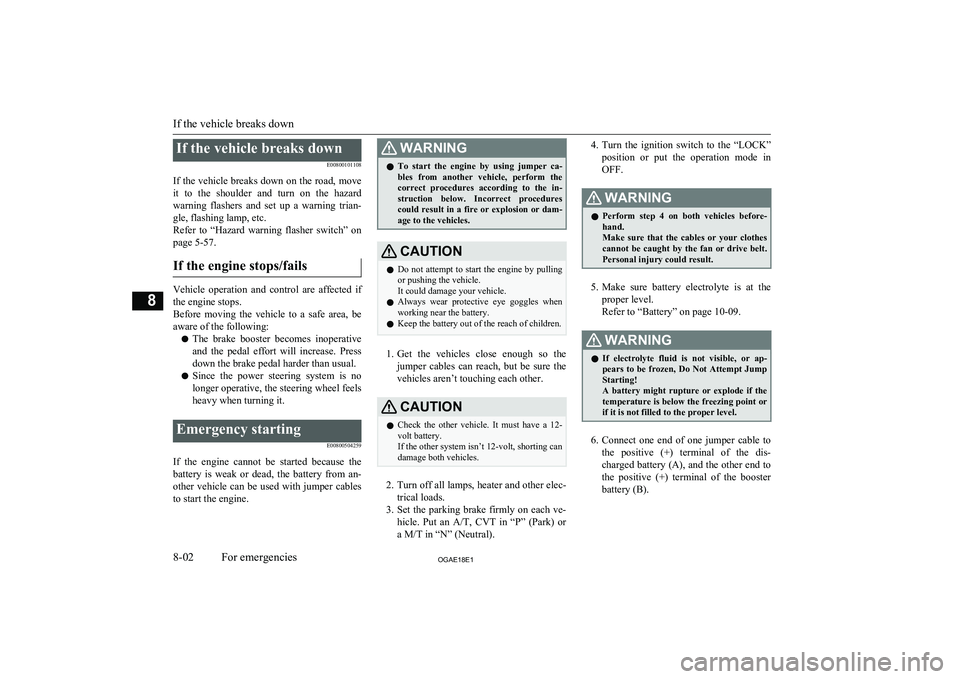
If the vehicle breaks downE00800101108
If the vehicle breaks down on the road, move it to the shoulder and turn on the hazard
warning flashers and set up a warning trian- gle, flashing lamp, etc.
Refer to “Hazard warning flasher switch” on
page 5-57.
If the engine stops/fails
Vehicle operation and control are affected if
the engine stops.
Before moving the vehicle to a safe area, be
aware of the following:
l The brake booster becomes inoperative
and the pedal effort will increase. Press down the brake pedal harder than usual.
l Since the power steering system is no
longer operative, the steering wheel feels
heavy when turning it.
Emergency starting
E00800504259
If the engine cannot be started because thebattery is weak or dead, the battery from an-other vehicle can be used with jumper cables to start the engine.
WARNINGl To start the engine by using jumper ca-
bles from another vehicle, perform thecorrect procedures according to the in-
struction below. Incorrect procedures could result in a fire or explosion or dam-
age to the vehicles.CAUTIONl Do not attempt to start the engine by pulling
or pushing the vehicle.
It could damage your vehicle.
l Always wear protective eye goggles when
working near the battery.
l Keep the battery out of the reach of children.
1.
Get the vehicles close enough so the
jumper cables can reach, but be sure the vehicles aren’t touching each other.
CAUTIONl Check the other vehicle. It must have a 12-
volt battery.
If the other system isn’t 12-volt, shorting can
damage both vehicles.
2. Turn off all lamps, heater and other elec-
trical loads.
3. Set the parking brake firmly on each ve-
hicle. Put an A/T, CVT in “P” (Park) or
a M/T in “N” (Neutral).
4. Turn the ignition switch to the “LOCK”
position or put the operation mode in
OFF.WARNINGl Perform step 4 on both vehicles before-
hand.
Make sure that the cables or your clothes
cannot be caught by the fan or drive belt.
Personal injury could result.
5. Make sure battery electrolyte is at the
proper level.
Refer to “Battery” on page 10-09.
WARNINGl If electrolyte fluid is not visible, or ap-
pears to be frozen, Do Not Attempt Jump
Starting!
A battery might rupture or explode if the temperature is below the freezing point orif it is not filled to the proper level.
6. Connect one end of one jumper cable to
the positive (+) terminal of the dis-charged battery (A), and the other end to
the positive (+) terminal of the booster
battery (B).
If the vehicle breaks down
8-02OGAE18E1For emergencies8
Page 345 of 514
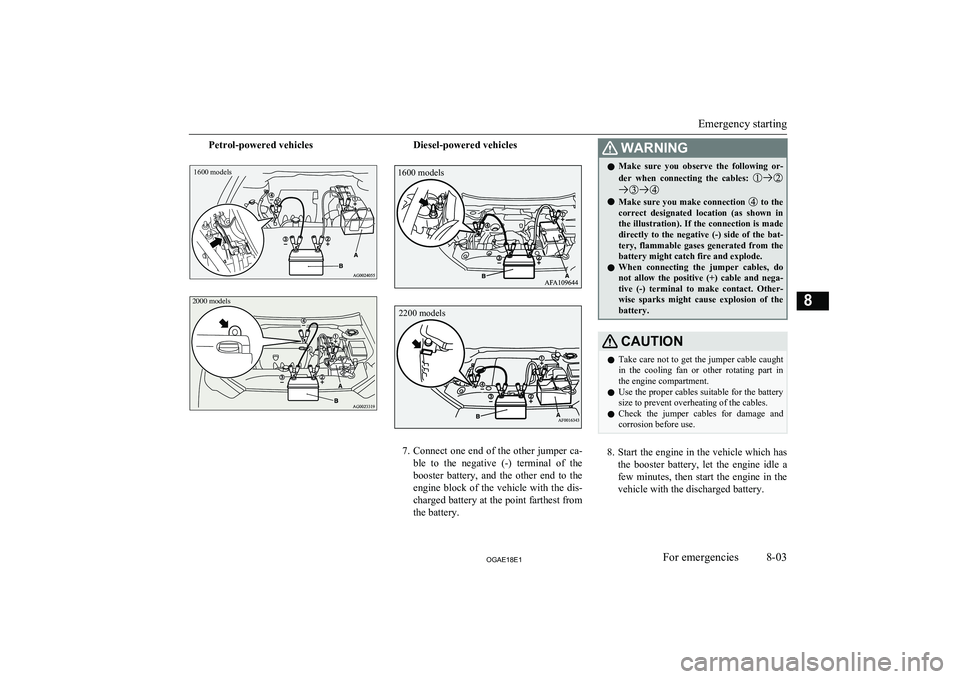
Petrol-powered vehicles1600 modelsDiesel-powered vehicles
7.Connect one end of the other jumper ca-
ble to the negative (-) terminal of the
booster battery, and the other end to the engine block of the vehicle with the dis-
charged battery at the point farthest from the battery.
WARNINGl Make sure you observe the following or-
der when connecting the cables:
l Make sure you make connection to the
correct designated location (as shown in the illustration). If the connection is made
directly to the negative (-) side of the bat- tery, flammable gases generated from the
battery might catch fire and explode.
l When connecting the jumper cables, do
not allow the positive (+) cable and nega-
tive (-) terminal to make contact. Other- wise sparks might cause explosion of the battery.
CAUTIONl Take care not to get the jumper cable caught
in the cooling fan or other rotating part in
the engine compartment.
l Use the proper cables suitable for the battery
size to prevent overheating of the cables.
l Check the jumper cables for damage and
corrosion before use.
8. Start the engine in the vehicle which has
the booster battery, let the engine idle a
few minutes, then start the engine in the vehicle with the discharged battery.
Emergency starting
8-03OGAE18E1For emergencies82000 models 1600 models 2200 models
Page 346 of 514
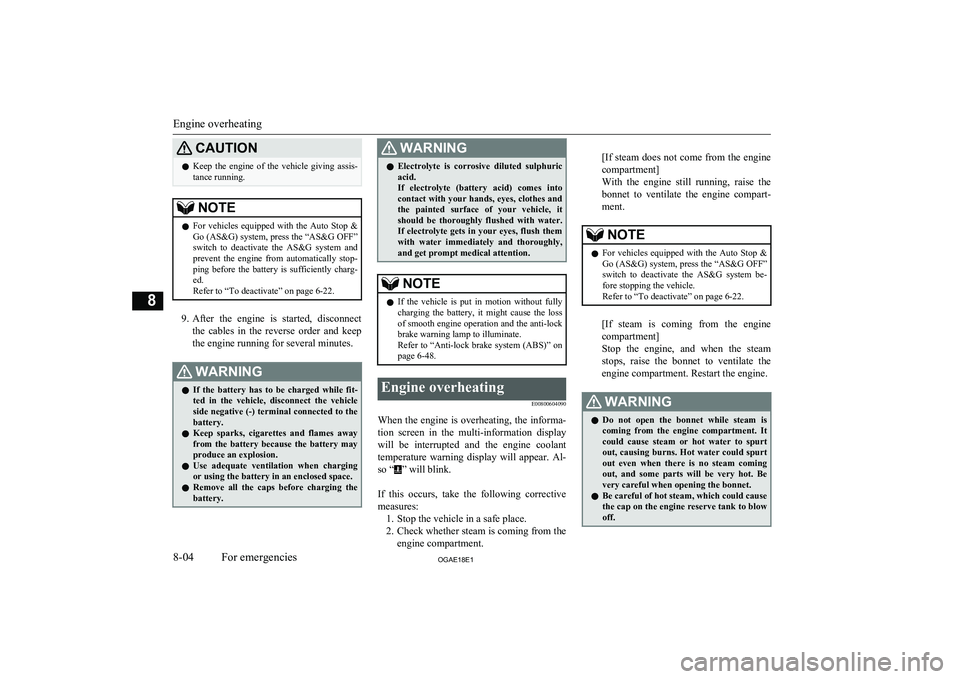
CAUTIONlKeep the engine of the vehicle giving assis-
tance running.NOTEl For vehicles equipped with the Auto Stop &
Go (AS&G) system, press the “AS&G OFF”switch to deactivate the AS&G system and
prevent the engine from automatically stop- ping before the battery is sufficiently charg-
ed.
Refer to “To deactivate” on page 6-22.
9. After the engine is started, disconnect
the cables in the reverse order and keep the engine running for several minutes.
WARNINGl If the battery has to be charged while fit-
ted in the vehicle, disconnect the vehicle side negative (-) terminal connected to the
battery.
l Keep sparks, cigarettes and flames away
from the battery because the battery may produce an explosion.
l Use adequate ventilation when charging
or using the battery in an enclosed space.
l Remove all the caps before charging the
battery.WARNINGl Electrolyte is corrosive diluted sulphuric
acid.
If electrolyte (battery acid) comes into contact with your hands, eyes, clothes and
the painted surface of your vehicle, it should be thoroughly flushed with water.If electrolyte gets in your eyes, flush them
with water immediately and thoroughly, and get prompt medical attention.NOTEl If the vehicle is put in motion without fully
charging the battery, it might cause the loss
of smooth engine operation and the anti-lock brake warning lamp to illuminate.
Refer to “Anti-lock brake system (ABS)” on
page 6-48.Engine overheating
E00800604090
When the engine is overheating, the informa-tion screen in the multi-information display
will be interrupted and the engine coolant
temperature warning display will appear. Al- so “
” will blink.
If this occurs, take the following corrective measures: 1. Stop the vehicle in a safe place.
2. Check whether steam is coming from the
engine compartment.
[If steam does not come from the engine
compartment]
With the engine still running, raise the
bonnet to ventilate the engine compart-
ment.NOTEl For vehicles equipped with the Auto Stop &
Go (AS&G) system, press the “AS&G OFF”switch to deactivate the AS&G system be-
fore stopping the vehicle.
Refer to “To deactivate” on page 6-22.
[If steam is coming from the engine
compartment]
Stop the engine, and when the steam
stops, raise the bonnet to ventilate the engine compartment. Restart the engine.
WARNINGl Do not open the bonnet while steam is
coming from the engine compartment. It
could cause steam or hot water to spurt out, causing burns. Hot water could spurt
out even when there is no steam coming out, and some parts will be very hot. Be
very careful when opening the bonnet.
l Be careful of hot steam, which could cause
the cap on the engine reserve tank to blow off.
Engine overheating
8-04OGAE18E1For emergencies8
Page 347 of 514
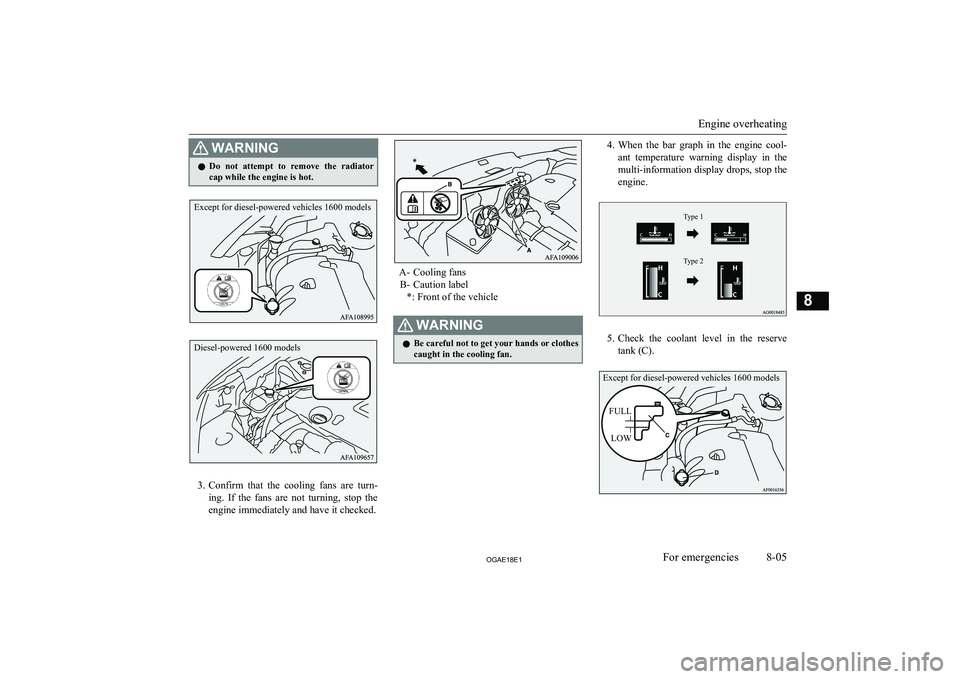
WARNINGlDo not attempt to remove the radiator
cap while the engine is hot.
3. Confirm that the cooling fans are turn-
ing. If the fans are not turning, stop the
engine immediately and have it checked.
A- Cooling fans
B- Caution label *: Front of the vehicle
WARNINGl Be careful not to get your hands or clothes
caught in the cooling fan.4. When the bar graph in the engine cool-
ant temperature warning display in the
multi-information display drops, stop the
engine.Type 1Type 2Type 1Type 2
5. Check the coolant level in the reserve
tank (C).
Engine overheating
8-05OGAE18E1For emergencies8 Except for diesel-powered vehicles 1600 models Diesel-powered 1600 models Except for diesel-powered vehicles 1600 modelsFULLLOW
Page 348 of 514
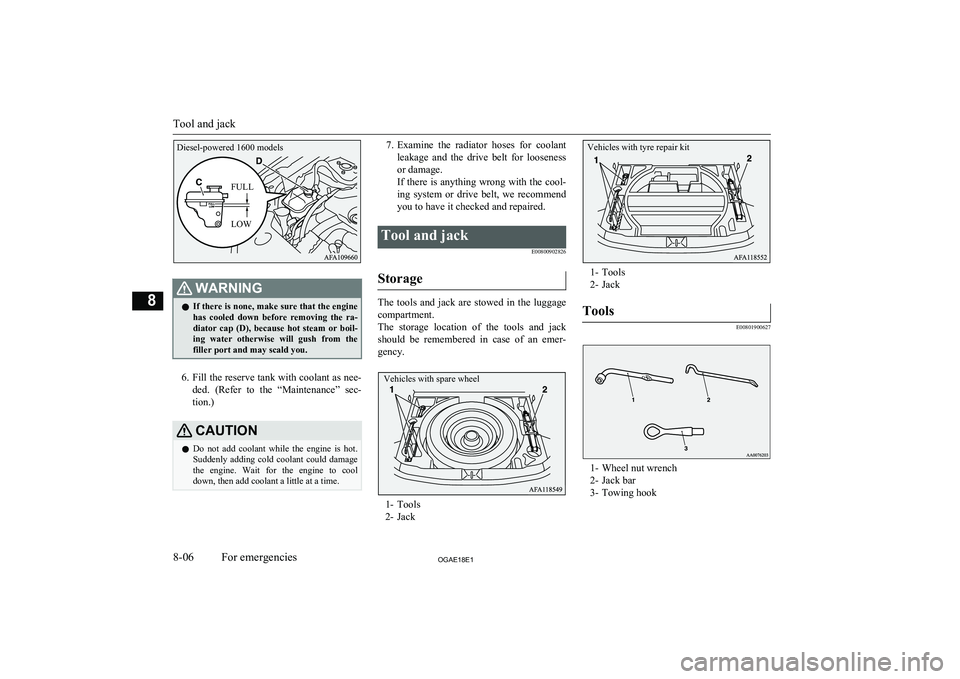
WARNINGlIf there is none, make sure that the engine
has cooled down before removing the ra-
diator cap (D), because hot steam or boil- ing water otherwise will gush from the filler port and may scald you.
6. Fill the reserve tank with coolant as nee-
ded. (Refer to the “Maintenance” sec- tion.)
CAUTIONl Do not add coolant while the engine is hot.
Suddenly adding cold coolant could damage
the engine. Wait for the engine to cool
down, then add coolant a little at a time.7. Examine the radiator hoses for coolant
leakage and the drive belt for looseness
or damage.
If there is anything wrong with the cool-
ing system or drive belt, we recommend
you to have it checked and repaired.Tool and jack
E00800902826
Storage
The tools and jack are stowed in the luggagecompartment.
The storage location of the tools and jack should be remembered in case of an emer-
gency.
1- Tools
2- Jack
1- Tools
2- Jack
Tools
E00801900627
1- Wheel nut wrench
2- Jack bar
3- Towing hook
Tool and jack
8-06OGAE18E1For emergencies8Diesel-powered 1600 modelsFULL
LOW Vehicles with spare wheel Vehicles with tyre repair kit
Page 349 of 514
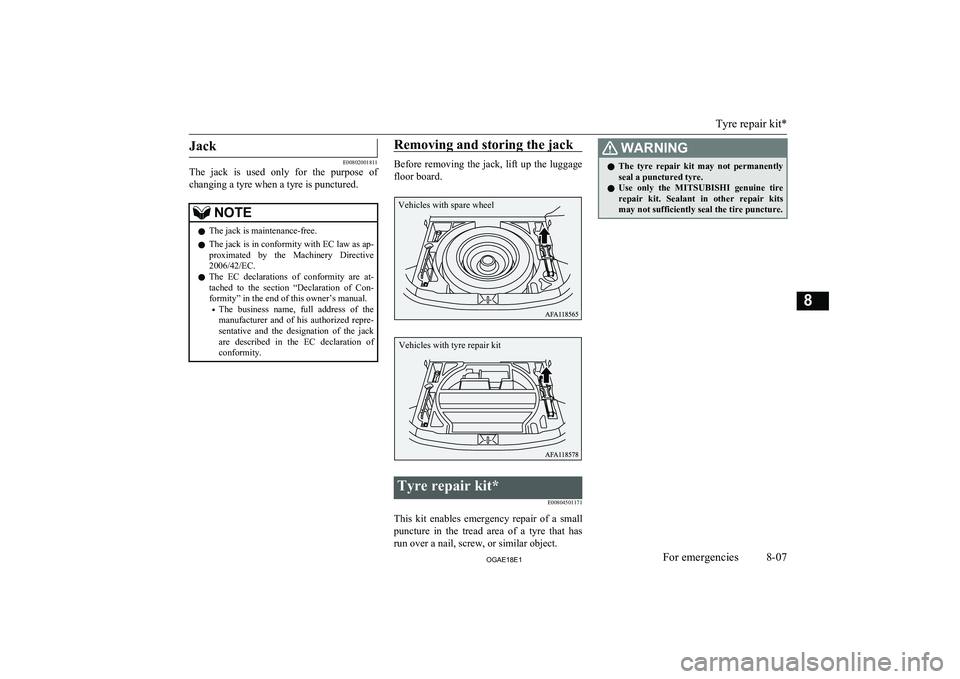
Jack
E00802001811
The jack is used only for the purpose of
changing a tyre when a tyre is punctured.
NOTEl The jack is maintenance-free.
l The jack is in conformity with EC law as ap-
proximated by the Machinery Directive
2006/42/EC.
l The EC declarations of conformity are at-
tached to the section “Declaration of Con- formity” in the end of this owner’s manual.
• The business name, full address of the
manufacturer and of his authorized repre- sentative and the designation of the jack are described in the EC declaration of
conformity.Removing and storing the jack
Before removing the jack, lift up the luggage
floor board.
Tyre repair kit*
E00804501171
This kit enables emergency repair of a smallpuncture in the tread area of a tyre that has
run over a nail, screw, or similar object.
WARNINGl The tyre repair kit may not permanently
seal a punctured tyre.
l Use only the
MITSUBISHI genuine tire
repair kit. Sealant in other repair kits
may not sufficiently seal the tire puncture.
Tyre repair kit*
8-07OGAE18E1For emergencies8 Vehicles with spare wheel Vehicles with tyre repair kit
Page 350 of 514
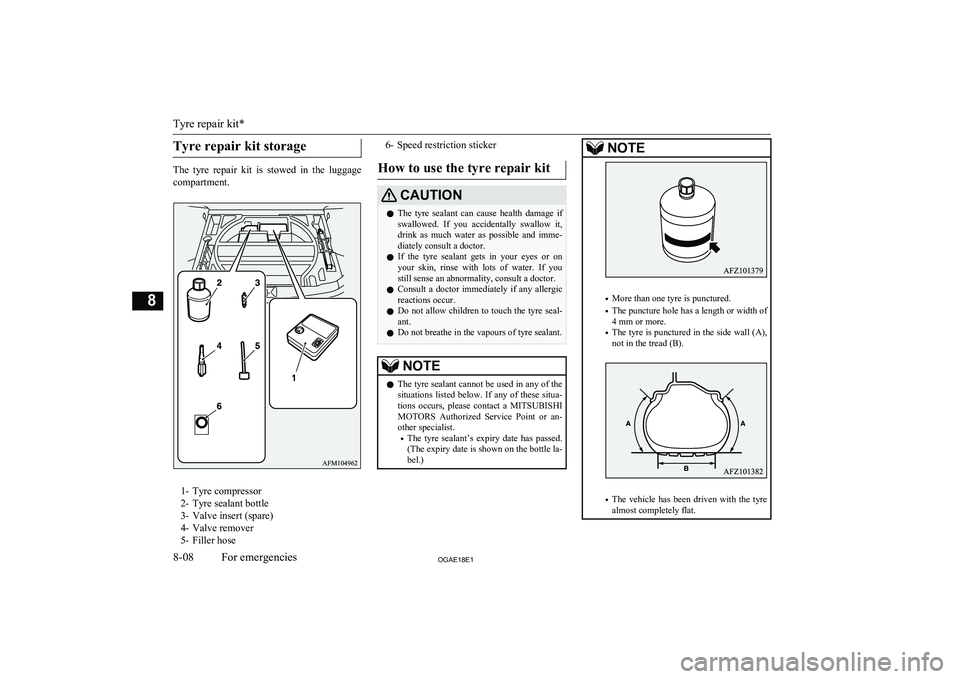
Tyre repair kit storage
The tyre repair kit is stowed in the luggagecompartment.
1- Tyre compressor
2- Tyre sealant bottle
3- Valve insert (spare)
4- Valve remover
5- Filler hose
6- Speed restriction sticker
How to use the tyre repair kitCAUTIONl The tyre sealant can cause health damage if
swallowed. If you accidentally swallow it,
drink as much water as possible and imme-
diately consult a doctor.
l If the tyre sealant gets in your eyes or on
your skin, rinse with lots of water. If you
still sense an abnormality, consult a doctor.
l Consult a doctor immediately if any allergic
reactions occur.
l Do not allow children to touch the tyre seal-
ant.
l Do not breathe in the vapours of tyre sealant.NOTEl
The tyre sealant cannot be used in any of the
situations listed below. If any of these situa-
tions occurs, please contact a MITSUBISHI
MOTORS Authorized Service Point or an-
other specialist.
• The tyre sealant’s expiry date has passed.
(The expiry date is shown on the bottle la- bel.)NOTE
• More than one tyre is punctured.
• The puncture hole has a length or width of
4 mm or more.
• The tyre is punctured in the side wall (A),
not in the tread (B).
• The vehicle has been driven with the tyre
almost completely flat.
Tyre repair kit*
8-08OGAE18E1For emergencies8